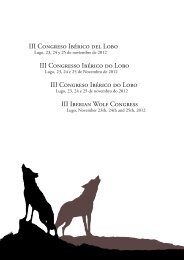Bison-Rewilding-Plan-2014
Bison-Rewilding-Plan-2014
Bison-Rewilding-Plan-2014
- No tags were found...
You also want an ePaper? Increase the reach of your titles
YUMPU automatically turns print PDFs into web optimized ePapers that Google loves.
3.3European bison as a keystoneand umbrella speciesA two-part definition of keystone species adaptedfrom R. Paine’s (1969) original work is often usedas a standard. The first part of this definition isthat the presence of keystone species ‘is crucialin maintaining the organization and diversity oftheir ecological communities’ (Mills et al. 1993).The second part of Paine’s standard keystonespecies definition deals with the relative importanceof the species. According to Mills et al. (1993),a keystone species must be ‘exceptional, relative tothe rest of the community, in their importance’.As the bison has been extinct for many decadesin Europe and now exists at reduced densities inoften managed populations, it is very difficultto infer the potential impact of bison on widercommunities of flora and fauna and thus defineit as a ‘keystone species’. However, several lines ofevidence do suggest that the species would have avital ecosystem-level function.Large herbivores are widely recognised tostrongly influence soil processes and the structureand diversity of plant communities. They canaffect vegetation directly by grazing or indirectlyby changing the turnover rates of nutrients. Herbivoresplay a key role in nitrogen turnover; theyrecycle nitrogen by eating plants and redistributingit through faeces and urine (Hobbs 1996),thus increasing the patchiness of nitrogen availability,plant distribution and growth. It has beenargued that plant species diversity has declineddue to an increase in fires following removal ofgrazing and so one of the goals of reintroducingbison to northern Spain, for example, is to preventfires and increase biodiversity (Fernando Moran,personal communication, 2010).On death, a large herbivore carcass also releasesa local and highly concentrated pulse of nutrientsinto the soil (Melis et al. 2007). Thus a EuropeanRUUD MAASKANT / ARK NATUREThe European Wildlife Bank<strong>Rewilding</strong> Europe founded a ‘wildlife bank’ to stimulate thebreeding of well adapted bison for rewilding projects. It is a toolfor <strong>Rewilding</strong> Europe to provide rewilding areas and initiativeswith bison and other large herbivores, by making so-calledcontracts with third parties, mostly land managers and owners inthe rewilding areas. On the expiration of the contract, individualanimals will be returned to the bank, where they may be usedfor a new contract. If animals are released fully into the wild (theultimate goal) they will not be returned to the bank. This will allowfor some control over herds and maintain a high quality/standardof bison reintroductions. Investors (partners) in the EuropeanWildlife Bank can expect a return on their investment based onthe animals’ reproduction rate. In <strong>Rewilding</strong> Europe areas wherebison cannot (yet) be released, the (semi-wild) enclosure facilitieswill provide breeding opportunities, as these ‘surplus’ animals willbe put in the wildlife bank. As these bison would be accustomedto living in semi-wild conditions they would be suitable forestablishing founder groups for other reintroductions.30



